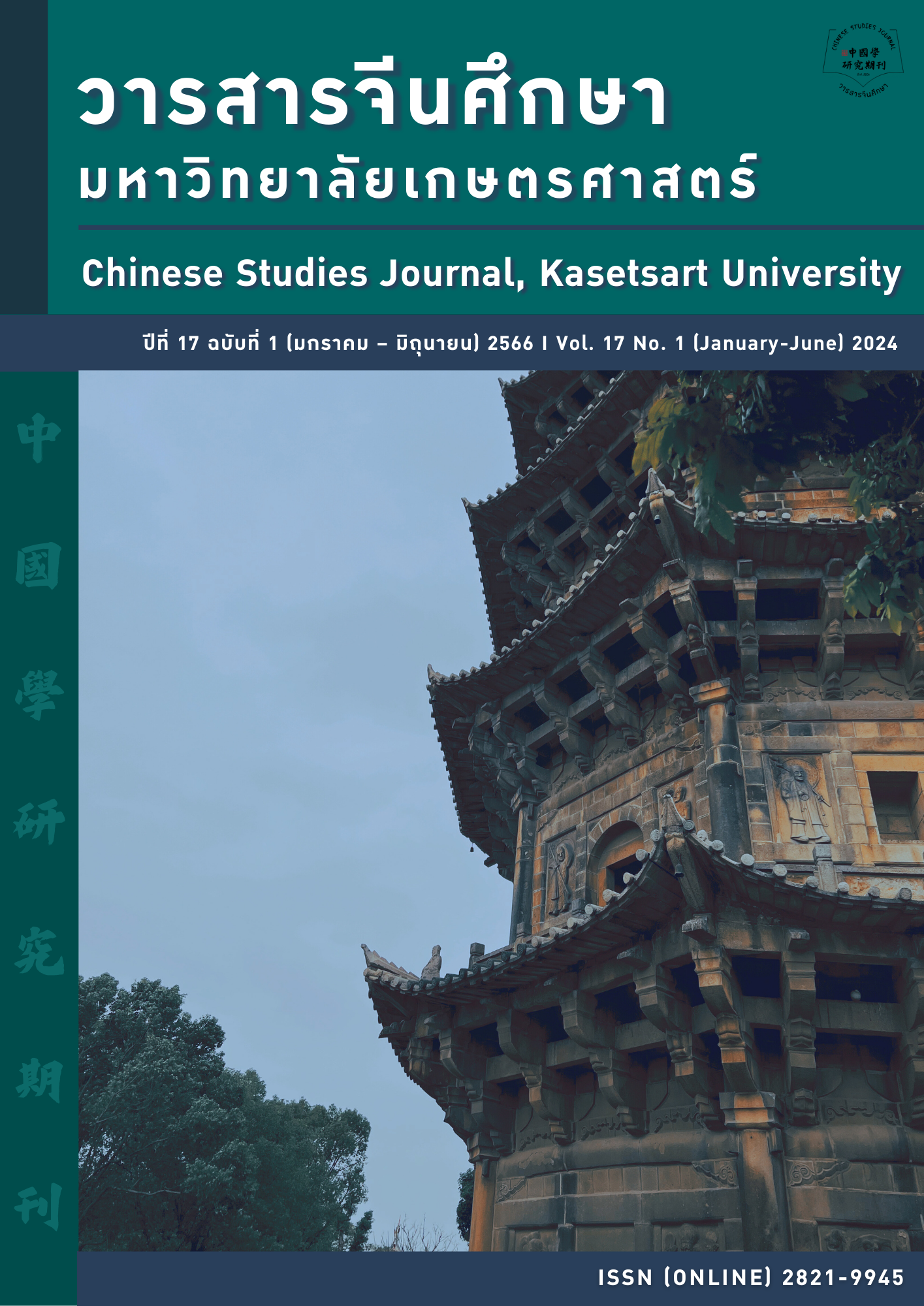The Inheritance and Development of Shanxi Daizhou Yellow Millet Wine การสืบสานและพัฒนาสุราเหลืองเมืองไต้โจวมณฑลซานซี
Main Article Content
Abstract
With socio-economic progress, technological advancements, and the exploration of cultural resources, the inheritance and development of intangible cultural heritage have garnered increasing attention. As a significant component of Chinese liquor culture, Shanxi Daizhou yellow millet wine brewing techniques were included in the third batch of the “Intangible Cultural Heritage List” of Shanxi Province in 2011.
This article aims to provide reference and guidance for the development and inheritance of Shanxi Daizhou yellow millet wine, promoting sustainable development. Within the framework of intangible cultural heritage, the study focuses on Shanxi Daizhou yellow millet wine, employing methods such as literature review, interviews, and questionnaire surveys. The exploration is divided into three main sections: first, the production background of Shanxi Daizhou yellow millet wine; second, the brewing process, inheritance methods, current development status, and challenges of Shanxi Daizhou yellow millet wine; and third, proposing strategies for the inheritance and development of Shanxi Daizhou yellow millet wine.
The research findings reveal that Shanxi Daizhou yellow millet wine, in its process of inheritance and development, shares similarities and challenges with many traditional crafts under the purview of intangible cultural heritage. However, it also possesses its uniqueness. The fundamental discoveries include: 1) Identifying inheritors of the brewing techniques within the consumer community of Daizhou yellow millet wine; 2) Introducing two new modes of inheritance for Daizhou yellow millet wine, namely “alternating inheritance between family and society" and "southern techniques and northern materials inheritance”; 3) For small to medium-scale intangible cultural heritage crafts like Daizhou yellow millet wine, industrialisation emerges as the preferred and optimal means for fostering the inheritance and development of traditional craftsmanship.
Article Details

This work is licensed under a Creative Commons Attribution-NonCommercial-NoDerivatives 4.0 International License.
ผลงานทางวิชาการที่ลงตีพิมพ์ในวารสารจีนศึกษา มหาวิทยาลัยเกษตรศาสตร์ เป็นลิขสิทธิ์ของผู้เขียนหรือผู้แปลผลงานนั้น หากนำลงในวารสารจีนศึกษาเป็นครั้งแรก เจ้าของผลงานสามารถนำไปตีพิมพ์ซ้ำในวารสารหรือหนังสืออื่นได้โดยมิต้องแจ้งให้ทราบล่วงหน้า แต่หากผลงานที่ได้รับพิจารณานำลงในวารสารจีนศึกษา เป็นผลงานที่เคยตีพิมพ์ที่อื่นมาก่อนเจ้าของผลงานต้องจัดการเรื่องปัญหาลิขสิทธิ์กับแหล่งพิมพ์แรกเอง หากเกิดปัญหาทางกฎหมาย ถือว่าไม่อยู่ในความรับผิดชอบของวารสารจีนศึกษา มหาวิทยาลัยเกษตรศาสตร์ ทั้งนี้ ความคิดเห็นต่างๆ ในบทความเป็นความคิดเห็นส่วนตัวของผู้เขียน ไม่เกี่ยวกับกองบรรณาธิการวารสารจีนศึกษา มหาวิทยาลัยเกษตรศาสตร์
References
Chen, G. Y. (2022). Influencing factors and guiding strategies of college students' learning engagement –Wisdom analysis based on online SPSSAU system. Education Research Monthly (3), 73–79.
https://doi/10.16477/j.cnki.issn1674-2311.2022.03.006
Daixian Local History Compilation Committee. (1988). Daixian Records. Bibliographic Literature Publishing.
Huang, Y. L. (2023). Inheritance Motivation and Protection Policies for Non-Genetic Inheritors. Journal of Guizhou Normal University (Social Science Edition) (3), 72-80. https://doi.org/10.16614/j.gznuj.skb.2023.03.007
Kennett-Hensel, P. A., & Allen, C. R. (2011). Uncorking the Mystery of Marketing Wine to Generation Y:
Lessons from Consumer Psychology. Marketing Management Journal, 21(2), 54-69.
https://www.mmaglobal.org/publications/MMJ/MMJ-Issues/2011-Fall/MMJ-2011-Fall-Vol21-Issue2-
KennettHensel-Neeley-Min-pp54-69.pdf
Liu, X. C. (2006). On the Inheritance and Inheritors. Journal of Henan Institute of Education (Philosophy
and Social Science Edition) (05), 24-36. https://doi.org/10.3969/j.issn.1006-2920.2006.05.003
Liu, X. C. (2010). Industrialisation of "Intangible Cultural Heritage": A Controversial Issue. Journal of
Henan Institute of Education (Philosophy and Social Science Edition) (04), 1-7.
CNKI:SUN:HZJX.0.2010-04-003
Liu, R. (2023, April 24). Provincial Intangible Cultural Heritage Representative Inheritor Li Quansuo
accepts apprentices to pass on his skills. Daixian Media Center.
https://www.daixianxinwen.com/newsdetails.html?index=null&id=10799
Ma, L. N., & Shan, M. L. (2022). From the revival of yellow wine perspective of China's "non-heritage"
products market countermeasures. Commodity Economy (6), 82-85.
https://doi/10.19995/j.cnki.CN10-1617/F7.2022.06.082.
Peng, Z. (2021). The Influence of Consumer Psychology on Purchasing Decisions. China Market (6), 2.
https://doi.org/10.13939/j.cnki.zgsc.2020.33.129
Ren, F. C. (2023, September 27). 2023 Daizhou Yellow Millet Wine Cultural Festival opens. Xinzhou
Online. http://www.xzrbw.cn/info/1215/346872.htm
Smith, L., & Akagawa, N. (2009). Intangible Heritage. Critical Issues In Cultural Heritage. Routledge.
Sun, J. Z., & Ma, L. Q. (2012). History of Wine and Wine Culture, No. 1 Series. Social Sciences Literature
Publishing House.
Tian, L. (2015). An Overview of the Industrialized Protection and Inheritance of Intangible Cultural
Heritage. Journal of Harbin Institute of Vocational Technology (2), 164-165.
https://doi.org/10.3969/j.issn.1008-8970.2015.02.080
Wang, Y. G. (2022). The Soul of Chinese Wine--Talking about the Inheritance and Innovative Development of China's Brewing Techniques (1). Winemaking (01), 2-4+11.
Wang, J. J. (2014). A Study on the Productive Protection of the Traditional Brewing Technique of Shui
Jing Fang Wine (Master's Thesis). Sichuan Academy of Social Sciences.
Zhang, M. (2020). Yellow Millet Wine Cultural Tourism Based on Tourists' Needs--Taking Shaoxing,
Zhejiang as an Example. Journal of Shaoxing College of Arts and Sciences (Humanities and Social
Sciences) (01). 67-71+120. https://doi.org/10.16169/j.issn.1008-293x.s.2020.01.012


